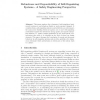Free Online Productivity Tools
i2Speak
i2Symbol
i2OCR
iTex2Img
iWeb2Print
iWeb2Shot
i2Type
iPdf2Split
iPdf2Merge
i2Bopomofo
i2Arabic
i2Style
i2Image
i2PDF
iLatex2Rtf
Sci2ools
SSS
2009
Springer
2009
Springer
Robustness and Dependability of Self-Organizing Systems - A Safety Engineering Perspective
Abstract. This paper analyses the robustness of self-organizing (engineered) systems to perturbations (faults or environmental changes). It considers that a self-organizing system is embedded into an environment, the main active building blocks are agents, one or more self-organizing mechanisms regulate the interaction among agents, and agents manipulate artifacts, i.e. passive entities maintained by the environment. Perturbations then need to be identified at the level of these four design elements. This paper discusses the boundaries of normal and abnormal behaviour in self-organizing systems and provides guidelines for designers to determine which perturbation in which part of the system leads to a failure.
Agents Manipulate Artifacts | Control Systems | Self-organizing | Self-organizing Mechanisms | SSS 2009 |
| Added | 27 May 2010 |
| Updated | 27 May 2010 |
| Type | Conference |
| Year | 2009 |
| Where | SSS |
| Authors | Giovanna Di Marzo Serugendo |
Comments (0)

